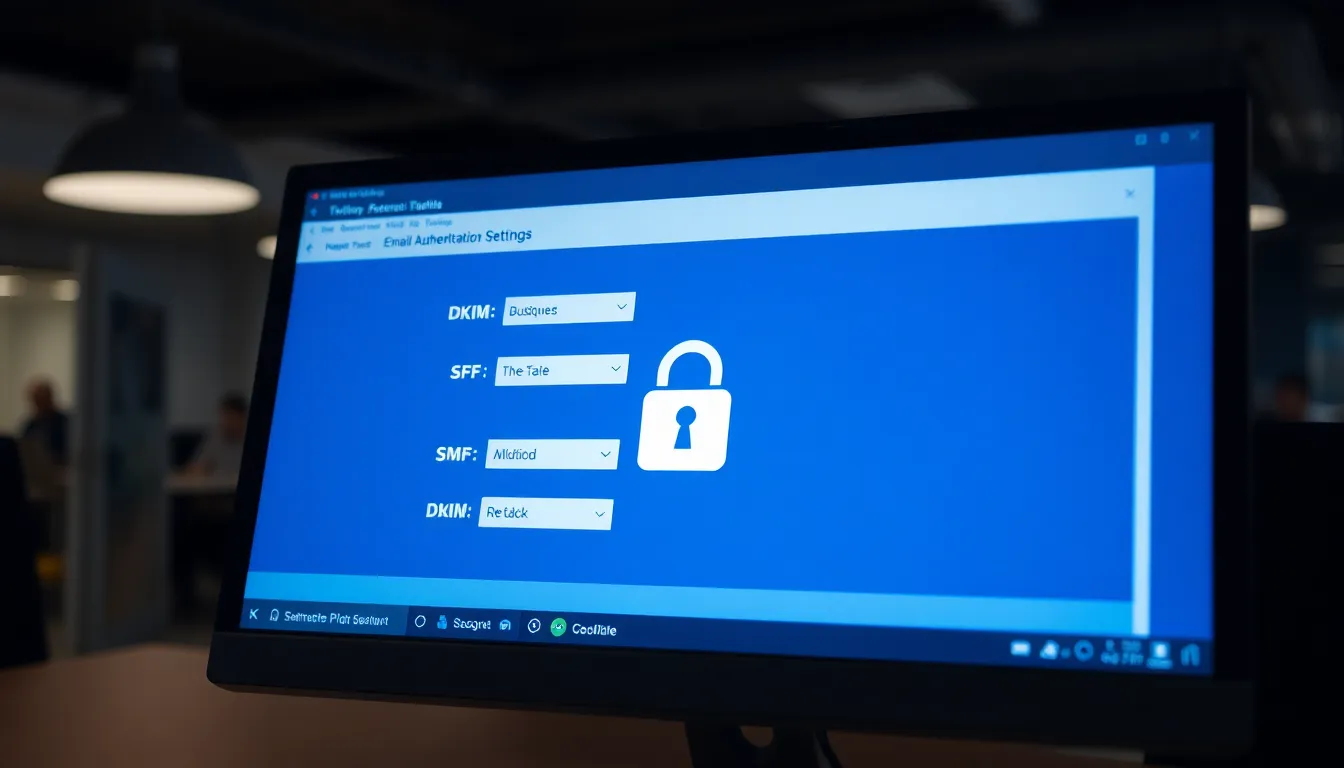In the wild world of email, where your messages can easily be mistaken for spam or phishing attempts, having the right security measures is crucial. Enter DKIM and SPF settings—the dynamic duo of email authentication. Think of them as the bouncers at the club of your inbox, ensuring only the right guests get in and keeping the unwanted riffraff out.
Table of Contents
ToggleOverview of DKIM and SPF Settings
DKIM and SPF settings play a critical role in email security. DKIM adds a digital signature to outgoing messages, verifying that the email originated from a specific domain. This signature helps recipients confirm the authenticity of the sender.
SPF, on the other hand, defines which mail servers are authorized to send emails on behalf of a domain. By setting up SPF records, domains can prevent unauthorized servers from sending spoofed messages. Both DKIM and SPF work together to improve email deliverability and protect against phishing attacks.
Implementing DKIM involves adding a public key to the DNS records. The sender’s server uses the private key for signing outgoing emails. When recipients’ servers receive these emails, they can validate signatures against the public key.
SPF records appear as TXT records in the domain’s DNS. They specify the IP addresses or hostnames of authorized mail servers. When a receiving server checks an incoming email, it consults the SPF record to ensure the sender’s IP matches the listed servers.
Together, these authentication methods establish trust in email communications. Each mechanism contributes to a robust security framework, reducing the likelihood of spam and phishing attacks. As more organizations adopt these settings, email communication becomes safer and more reliable across the internet.
DKIM and SPF settings aren’t only beneficial for individual users. Businesses also leverage these tools to protect their reputations and ensure that their communications reach intended recipients without disruption.
Importance of DKIM and SPF Settings

DKIM and SPF settings play a crucial role in maintaining email security and ensuring message integrity. These mechanisms form an essential foundation for trustworthy email communications.
Enhancing Email Deliverability
Implementing DKIM and SPF significantly boosts email deliverability rates. They signal to receiving servers that the emails originate from verified sources. Authentication improves the chances of emails reaching inboxes rather than getting filtered into spam folders. Organizations can expect higher engagement rates when legitimate emails are received successfully. Effective email marketing campaigns rely on these standards to ensure messages are delivered promptly and remain visible to the audience. Without these settings, the risk of emails being marked as suspicious increases, which could lead to lost opportunities.
Protecting Against Spoofing and Phishing
DKIM and SPF settings protect domains from spoofing and phishing attacks. These protocols verify the authenticity of emails, helping to distinguish between legitimate messages and fraudulent attempts. Unauthorized senders find it challenging to impersonate trusted domains, reducing the likelihood of successful attacks. Users experience a safer inbox when these measures are employed. DKIM adds a digital signature, while SPF lists authorized mail servers within DNS records. Collectively, they create a robust defense against malicious activities aimed at compromising user security.
How DKIM Works
DKIM, or DomainKeys Identified Mail, enhances email security by adding a digital signature to messages. This signature authenticates the domain that sent the email, making it easier to detect spoofing and phishing attacks.
Key Components of DKIM
Key components include the private key, public key, and DKIM header. The private key, kept safe on the sending mail server, generates the signature. The public key is published in the domain’s DNS records, enabling the recipient’s server to verify the signature. The DKIM header is attached to the email and contains the signature along with the signing domain. These components work together to ensure that even if the email content changes during transit, the signature remains intact. This verification process reduces the chances of emails being flagged as spam.
Implementing DKIM Settings
Implementing DKIM involves several specific steps. First, a domain owner generates a public-private key pair. Next, the public key gets published in the domain’s DNS records as a TXT record. Then, the mail server configuration requires entering the private key to sign outgoing emails. Testing the setup ensures that the DKIM signatures are being applied correctly. Monitoring DKIM reports helps identify any issues, allowing timely adjustments. Following these steps creates a secure email environment, increasing trust among users and enhancing overall deliverability.
How SPF Works
SPF enhances email authentication by specifying which mail servers are authorized to send emails for a domain. This mechanism helps prevent unauthorized users from sending spoofed emails.
Key Components of SPF
Key components of SPF include SPF records, which reside in the Domain Name System (DNS). These records contain a list of authorized mail servers. Each authorized server is identified by its IP address or domain name. The SPF record also includes modifiers to adjust its behavior, such as including or excluding other records. When an email is sent, the receiving server checks the SPF record to verify the sender’s legitimacy. If the sending server’s IP matches an entry in the SPF record, the email is accepted as valid. Otherwise, it may be flagged as spam or rejected.
Implementing SPF Settings
Implementing SPF settings requires creating an SPF record in the domain’s DNS. Start by determining which mail servers send emails on behalf of the domain. Next, craft the SPF record to list those authorized servers while ensuring proper syntax. After creating the record, publish it in the DNS. Use tools, like SPF validators, to check for errors in the record configuration. Monitoring SPF reports can identify issues and adjust settings as needed. Proper implementation increases deliverability rates, enhancing overall email security.
Common Issues and Troubleshooting
Misconfigurations often lead to issues with DKIM and SPF settings. A common problem involves SPF records not being correctly published in the DNS. Checking the DNS for the correct syntax and format can alleviate this issue. Sometimes, an SPF record might exceed 10 DNS lookups, resulting in SPF failures. Keeping the number of lookups under the threshold ensures successful email authentication.
DKIM failures may occur when the public key is not accurately listed in the DNS. Verifying that the public key matches what’s configured on the mail server is crucial. Additionally, an email lacking the DKIM signature may be flagged as suspicious. Ensuring that outgoing emails are signed by the private key avoids this problem.
Another frequent challenge involves using multiple email services without proper configuration. Each service needs its DKIM and SPF setups to function correctly. Overlapping services can create conflicts, which hinder email deliverability. Listing all authorized mail servers in the SPF record prevents these conflicts.
Monitoring email logs provides insight into delivery issues related to DKIM and SPF. Logs often reveal whether emails are being rejected due to authentication failures. Reviewing these logs regularly helps identify and resolve recurring problems.
Lastly, many organizations neglect to refresh DKIM and SPF records after changes to their mail architecture. Keeping these records up to date ensures ongoing compliance with best practices. Addressing these common issues can significantly improve email deliverability rates and enhance overall security.
Implementing DKIM and SPF settings is essential for anyone serious about email security. These tools not only protect against spoofing and phishing but also enhance the overall trustworthiness of email communications. By ensuring that only authorized senders can send emails on behalf of a domain, they significantly improve deliverability rates.
Regular monitoring and updating of these records are crucial for maintaining their effectiveness. As email threats continue to evolve, staying ahead with robust authentication methods like DKIM and SPF becomes increasingly important. This proactive approach safeguards both personal and business communications, fostering a safer online environment for everyone.






